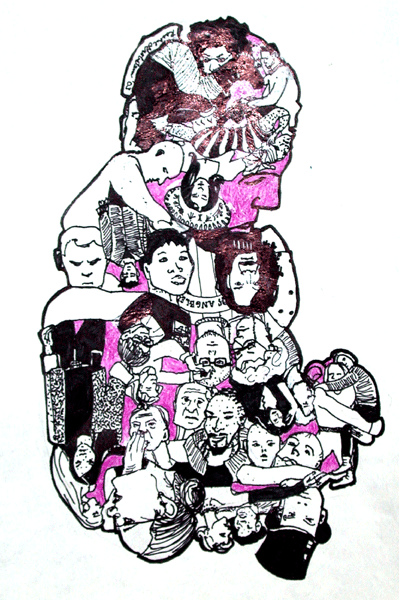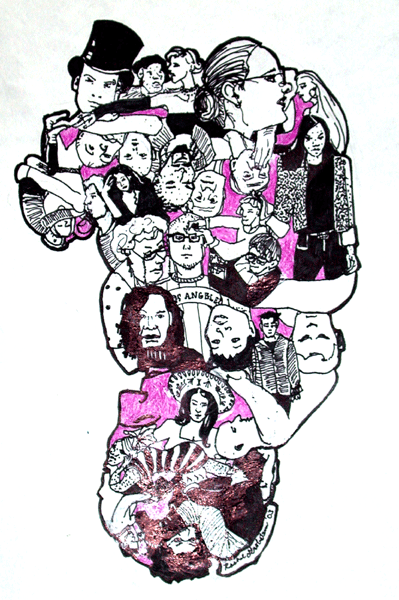Made available on Serendip
In association with Making Sense of Diversity: An Exploration, a world wide conversation

|
March 3, 2006
Liza Jane Bernard, Sally Harrison,
Pim Higginson, John Duronville, Amanda David, Hannah Upp
Perception of the Other: Bryn Mawr and Haverford
Participants
Summary
Prepared by Vanessa Christman
Additions, revisions, extensions are encouraged
in the On-Line Forum
| 
|
Note: Although this conversation was publicized at Haverford, only one person from Haverford (John, one of the facilitators) attended the discussion. This may be important to bear in mind when reading over the comments.
To start the conversation, Hannah Upp presented an overview of the topics to be addressed:
- What have Bi-Co relations been like in the past?
- How are they now?
- Finally, how do we judge another group (the “other”) based on where we are?
The facilitators then provided their perspectives.
John Duronville started. He's a junior at Haverford. As a high school freshman, he was introduced to both Haverford and Bryn Mawr. Bryn Mawr seemed like a resource that would always be there if he applied to either Haverford or Swarthmore. He felt there was no clear cut separation—except that he couldn't apply here. As soon as got on campus, he took a daily Spanish course at Bryn Mawr—and he ate lunch here (which was a benefit).
Sally interjected—“The food's better here—there's a perception.”
John continued—He had friends he'd made in the Tri-Co Summer Institute. And because the campuses are so small, it was good to have a little change by going to the other schools. BUT—he realized quickly that his perception was not everyone's. He learned some people saw the Customs bi-co events as forced interaction. They'd applied to Haverford and wanted to be at Haverford, they said. But for John it has been a good experience. He sees BMC as more culturally rich than Haverford. Bryn Mawr has good activities, like its traditions, events at TGH presented by Sisterhood and BACaSO, etc. Such things have made his experience at Haverford more worthwhile.
Sally Harrison, who's in charge of major gifts in BMC's Resources office, joked that she represents the ancient history of the two colleges. She was here from 1967-1971, a classmate of Karen Tidmarsh. She thinks the BMC-Haverford relationship was really solidifying then. She was one of the first women to live on Haverford's campus and became a Quaker largely because of Haverford's influence on her life. Now when she goes to talk to individuals, she shares information about latter-day bi-co life.
Pim Higginson, assistant professor in the French department and director of the African studies program, went to UC Berkeley—which was “public, huge, and impersonal.” He said it seems strange to be in this hothouse environment; there are few if any traditions at Berkeley, and those that exist are scoffed at. People form communities there just not to be lost in such a huge place. He has taught at all three institutions, which gives him perspective. He spoke of being jealous of the intimacy and caring at BMC on one hand; on the other hand, he still thinks he would have chosen Berkeley for his college experience. “This intimacy,” he marveled, “—everybody's on top of each other here in a way that seems strange.” But he said he felt closer to students here than he would at a larger place. Pim was an Americanist in college, specializing in African-American lit, and he continues to be interested in racial matters. He wonders that more of a discussion on race did not occur at the Bi-Co level. There have been rough spots, but there has not been a discussion of how these questions arise on each campus, or of what it says about what's going on on each campus. Next semester at Bryn Mawr there will be a discussion about Diaspora identities, to talk about similarities/solidarities and differences. Even people who aren't directly involved will realize the enormous diversity within those communities. He hopes Haverford will be included.
Liza Jane Bernard, Director of Career Development, came to Haverford and BMC in 1985, the same year the CDO became bi-co. She said she loves both these institutions. Her goal is to make the bi-co aspect of the office and its services seamless, and to that end the staffs are very knowledgeable about each campus. As a bi-co office, Career Development is able to offer employers twice as many students. There is a bi-co alumni body of over 31,000, including several hundred bi-co married couples.
Liza Jane shared the results of a trivia quiz that was given not long ago during customs week. (Answers follow each question in parentheses.)
- How long have Bi-Co students been able to take courses at “the other college” for credit? (More than 35 years)
- By what year could students major in any department at either college? (1977)
- In what year could Bi-Co students first enjoy the excellent cuisine in either college's dining services as part of the meal plan? (1967)
- In what year could students first reside at either college? (1969)
- What was the “Social Bus”? (A weekend bus between BMC and HC once funded by SC and SGA)
She sees a lot of differences that make the bi-co experience richer and more complicated. A student may find an emotional “home” at the other. She encourages gaining more experience with each other.
Hannah Upp, Bryn Mawr junior with a Bi-Co major and participant in a Bi-Co choral group, wound up the facilitators' comments. Her perception of the past Bi-Co relationship is that it was more student driven. Now it seems more academic and less social. She still feels there's a stigma of the “other”—whether it's Haverford or BMC.
In exploring this notion, she proposed an ACTIVITY and asked the participants to jot down stereotypes of each college. Some results of this activity follow, along with some of the discussion a particular stereotype generated when read aloud:
Haverford is the least cool of the Tri-Co
Haverford women are uptight around Bryn Mawr women
Bryn Mawr = crazy feminists
All Haverford guys are short and hairy
Haverford is academically harder (US News ranks Haverford higher = excuse for Haverford to say they're better than Bryn Mawr. But this list is not static; it changes)
Bryn Mawr College students use Bryn Mawr as a back door entrance to Haverford
Haverford is more democratic—more Quaker; Bryn Mawr is more hierarchical and tradition-bound (Yes, w/in classes as well)
Bryn Mawr women are too eccentric and socially awkward
Bryn Mawr is more academic
Haverford = less culturally and ethnically diverse than BMC
There's more financial aid at BMC. (Are the statistics accurate? Who has wealthier students? BMC puts almost twice as many dollars into financial aid than Haverford.)
Haverford women think BMC women are out to steal their men (“As much as we laugh, this is a strong dynamic” “The possessive is amusing.” “AND heterosexist.”
BMC is more formal; Haverford is more relaxed (“That's true—e.g., faculty called by first names)
All Haverford students are rich and privileged. (“So what does that mean, in terms of class? “I never heard of it in class terms. Styles, tastes—pop culture.” “All are privileged to be at these colleges.” “Neither college is as materialistic as your high schools were.” “What it takes to be popular—seems so different at other colleges away from here—cars, hair, etc. But here not a worry. Ostentation not a thing here.”
Bryn Mawr has more visible work study—in the dining halls—which gives the impression we work harder for our education. At Haverford, work study is hidden. (Perception = Haverford students never have to work. “Volvos from CT.” Haverford does have less student labor in dining services.”)
Haverford men are like frat boys. (“You ain't been around frat boys if you think that's true.”)
All Bryn Mawr students are lesbians (That's why they're stealing “our men.”!)
What about the notion of other ?
It's like we build our ID based on the other. Oppositional, rather than learning from each other.
Why aren't there more bi-co organizations?
Small turnouts—no coalitions. First we have to know what's going on here.
“I run a bi-co campus ministry. We have a hard time attracting Haverford students—no one wants to be the lone Haverford student.”
To sum up, someone quipped: The relationship is like brother-sister—sometimes love, sometimes hate—but for both, Swarthmore is like a distant cousin!
| Return to Schedule for Friday Noon Conversations

| Bryn Mawr Conversations
| Archived
Forum
| Archive of Bryn Mawr Conversation
| General Conversation
| Serendip Home |
These pages are sponsored by the Bryn Mawr College Office
of Intercultural Affairs, the Center for Science and Society and the Serendip
website. Send us additional comments or suggestions at Serendip
© by Serendip 1994-
- Last Modified:
Wednesday, 21-June-2005 15:18:00 EST

